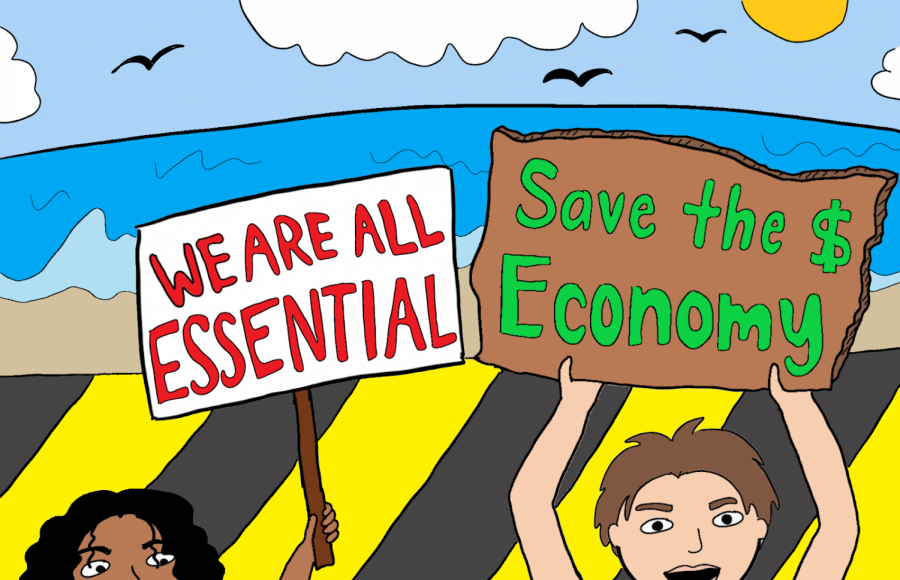Stay-at-Home Protests Inspire Economic and Social Resurgence within California, Starting with OC Beaches
Protests have spawned across California in an act to challenge the state’s stay-at-home order and social distancing restrictions.
Amid Gov. Gavin Newsom’s crippling stay-at-home lockdown, sporadic protests have erupted across California. While state officials are slow to act with the state’s economic decline and continue to extend public restrictions, protestors are inspiring a statewide movement to restore California to normalcy – starting with Orange County beaches.
Newsom issued a closure of Orange County beaches on April 30 and faced an immediate legal backlash from cities, including Huntington Beach and Dana Point. With the order, he not only constricted a vital facet of the county’s economy – in Newport Beach alone, beach-related tourism, services and hospitality generate $13.5 million in monthly revenue, according to the Los Angeles Times – but also stripped a defining aspect of cultural identity and livelihood from residents and students.
“[The order was] not fair to the residents of Orange County,” sophomore Andrew Cherry said. “Beaches are in fact used by many multiple times a week including myself, [and] I did not feel like it was the right decision. Instead of closing off everything, the governor should have instituted more extensive rules regarding the usage of the beach.”
Orange County supervisor Don Wagner cited countywide stay-at-home compliance and mental health concerns in denunciation of the beach closures.
“Medical professionals tell us the importance of fresh air and sunlight in fighting infectious diseases, including mental health benefits,” Wagner said on NBC Los Angeles. “Moreover, Orange County citizens have been cooperative with California state and county restrictions thus far.”
Orange County sustains one of the lowest deaths per capita and infections per capita within California – approximately 1.6 deaths due to COVID-19 per 100,000 residents, according to the Orange County Register.
Huntington Beach, with a population of approximately 200,000, has reported only 291 cases cumulatively and zero COVID-19 related deaths, according to the Orange County Health Care Agency.
“Given that Orange County has among the lowest per-capita COVID-19 death rates in California, the action by the state prioritizes politics over data, in direct contradiction of the governor’s stated goal to allow science and facts to guide our response to this horrible global pandemic,” Huntington Beach mayor Lyn Semeta said in a public statement.
Thousands of Orange County residents organized demonstrations and centralized their protests against the beach closures. Huntington Beach alone reported over 3,500 demonstrators at a single rally on May 1, according to the Guardian.
The Newport Beach City Council rejected a state proposal to extend beach closures in a 5-2 vote, according to Fox 11 Los Angeles. The council also voiced support of a lawsuit filed by Huntington Beach, Dana Point, and local business owners to reopen Orange County beaches on May 2.
After just three days, Laguna Beach, San Clemente, Dana Point, Seal Beach and Huntington Beach successfully garnered approval to reopen beaches by May 11, overturning an order intended to span three weeks.
With the help of legal pressure and stay-at-home protests, California has begun its transition back to normalcy. However, the fight to reopen is still ongoing in other sectors, and more action needs to be taken now to prevent further economic losses.
Newsom unveiled Stage 2 of California’s reopening phase on May 4, enabling a select few nonessential retailers to ease into resumption of business practices.
However, Stage 2 came just days before California recorded a $54.3 billion deficit on May 7 and projected a statewide unemployment rate at 18 percent, according to the New York Times. This is comparable to a 24.9 percent unemployment rate during the Great Depression, the worst economic crisis in history.
“We in Orange County lost 13,200 jobs in March [alone],” Orange County supervisor Michelle Steel said in an ABC7 Interview. “It is because of this drastic increase in unemployment that we must begin the process of safely allowing businesses to reopen.”
No longer should COVID-19 be perceived as a suppressing force, thwarting chances at economic and social resurgence. Rather, this is an opportunity to voice opinions and eliminate the restrictions that are wreaking havoc upon businesses and social wellbeing.
Your donation will support the student journalists of Portola High School. Your contribution will allow us to purchase equipment and cover our annual website hosting costs.

Ryne Dunman is the Co-Editor-in-Chief for his second and final year on the Portola Pilot. This year, he’s excited to make new memories in-person and...

Krisha Konchadi is the front page editor this year on the Portola Pilot. Along with editing and creating the front page, she loves making graphics and...




